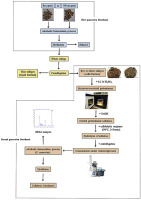Biomass & Bioenergy ( IF 5.8 ) Pub Date : 2020-03-16 , DOI: 10.1016/j.biombioe.2020.105528 Dawid Mikulski , Grzegorz Kłosowski

|
The main problem in the production of cellulosic ethanol is to ensure an efficient and cost-effective raw material pretreatment, guaranteeing a high degree of lignocellulose decomposition. Microwave radiation can be an alternative to conventional biomass heating, which in association with the use of dilute acid and a cellulolytic enzyme ensures a high degree of cellulose degradation. We evaluated the effectiveness of microwave dilute acid pretreatment of wheat and rye stillage in terms of the amount of sugars released, formation of fermentation inhibitors and their removal, and fermentation efficiency. Regardless of the type of stillage used, the highest glucose concentration after pretreatment (above 156 mg g−1 of DW) and the highest yield of cellulose hydrolysis after 24 h of the process (over 75%) were obtained using microwave power of 300 W, 15 min, 54 PSI. Fermentation of lignocellulosic hydrolysates obtained under the above-mentioned conditions ensured high ethanol concentrations of up to 20 g L−1 with full attenuation after just 48 h. Too intensive microwave treatment (152 PSI, 10 min) increased the concentration of sugar dehydration products which inhibited yeast fermentation activity and led to a lower ethanol yield. Detoxification with activated carbon reduced the toxic stress caused by the high concentration of HMF in hydrolysates. The application of microwaves is an interesting alternative to conventional barothermal methods. The possibility of an effective use of waste biomass of wheat/rye stillage for the production of cellulosic ethanol creates a prospect of integrating first and second generation ethanol production within one technological process.
中文翻译:

微波辅助稀酸预处理在小麦和黑麦蒸馏物中生产生物乙醇
纤维素乙醇生产中的主要问题是确保高效且具有成本效益的原料预处理,从而确保木质纤维素的高度分解。微波辐射可以替代传统的生物质加热,与使用稀酸和纤维素分解酶结合使用可确保高度的纤维素降解。我们根据释放的糖量,发酵抑制剂的形成及其去除以及发酵效率,评估了小麦和黑麦釜馏物的微波稀酸预处理的有效性。无论使用哪种蒸馏器,预处理后的最高葡萄糖浓度(高于156 mg g -1使用300 W,15分钟,54 PSI的微波功率,在处理24小时后(超过75%)获得了最高的纤维素水解收率。在上述条件下获得的木质纤维素水解产物的发酵确保了高达20 g L -1的高乙醇浓度在48小时后完全衰减。太强的微波处理(152 PSI,10分钟)会增加糖脱水产物的浓度,从而抑制酵母发酵活性并导致乙醇产量降低。用活性炭排毒可减少由水解产物中高浓度HMF引起的毒性应激。微波的应用是常规重压法的一种有趣的替代方法。有效地利用小麦/黑麦废料的废弃生物质生产纤维素乙醇的可能性为将第一代和第二代乙醇生产整合到一个技术过程中创造了前景。











































 京公网安备 11010802027423号
京公网安备 11010802027423号